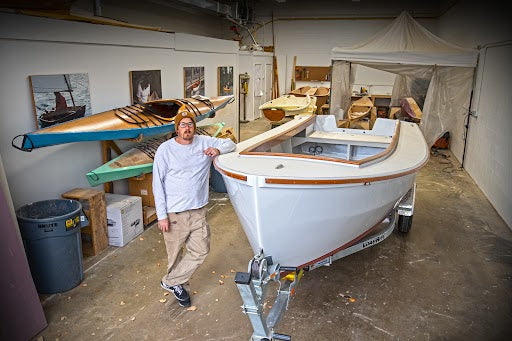
It was 16 years after Mbuli' s release that we've revisited this fun design. While no changes have been made to the design or construction, we took that opportunity to increase the level of detail in the plans, expanding them from seven to 11 pages.
Mbuli was featured in WoodenBoat Magazine's Nov/Dec 2002 Issue
Mbuli (pronounced em-BOO-lee) is a Pacific proa designed and built by John Harris at CLC in 1999 and 2000. The original design brief called for a lightweight beach cruiser, easy to build, and capable of carrying one or two people around protected waters at faster-than-average speeds. As such, it was a successful design, much admired and coveted. Quite a few have been built around the world. A larger sister, Madness, followed a few years later.
A Pacific proa is a type of sailing canoe that has been widely used in the South Pacific for thousands of years. Mbuli is obviously a modernized proa, but the principle is the same: there is a big hull, which holds the rig and accommodations, and is attached to a small hull to windward for stability. In this case the crew operates the proa from the trampoline stretched between the two hulls.
The outrigger, or "ama," is meant to be kept to windward at all times. Sailors will immediately recognize that this begets some curious handling; to tack, Mbuli must in effect perform a three-point turn. This maneuver is known as "shunting," and if you’ve had some sailing experience you’ll find it not only easy to do but a fast way to change direction. Look at our Madness proa to find videos about how these boats are sailed
The need to "shunt" instead of tack in the traditional manner is one of the Pacific proa’s idiosyncrasies, but there’s a reason for it: proas can have larger rigs than other multihulls of equivalent length, and can also be 30% lighter even with that larger rig. All this translates into a lot of speed in a small, lightweight package. The all-up weight using Okoume plywood is around 450 lbs., with that much again available for crew and cargo.
The unstayed schooner rig was chosen for easy handling. The prototype’s wing masts permitted awesome speeds, but they were very tricky and expensive to build and require a highly skilled and athletic crew. The hollow, tapered masts shown in the drawings will offer exhilarating speeds without compromising Mbuli’s beach-cruising style and were used on subsequent boats built from the plans.
Mbuli has a small watertight enclosed cabin measuring 8’ x 2’. This compartment is kept closed under sail, but at anchor or on the beach it makes a nice sleeping space for one adult. The big windows ensure that you don’t get claustrophobic. Many builders will elect to sleep on the 8’ x 10’ trampoline. You could even erect a traditional tent on the trampoline. The bow and stern have watertight compartments and are available for storage. Additional storage for anchor and lines are provided in the ama.
The crossbeams, or "akas," are 4" aluminum tubes. Mbuli can be broken down for trailering in less than an hour.
Construction is of 1/4" okoume plywood covered with epoxy and fiberglass. Plans are not extravagantly detailed and are intended for builders who may have built a small boat or two. The lifting rudder-daggerboards and the hollow masts are the most challenging part to tackle. Total cost of the project, including the best materials, high quality sails, and a lightweight trailer should be under $10,000.
Mbuli is meant for protected waters and isn’t ideal for first-time sailors. However, skilled sailors with some multihull experience will be rewarded with remarkable performance upwind and down, speeds in excess of 15 knots, and a fun platform for beach-cruising.
Plans include eleven 24" x 36" sheets with detailed construction drawings. Offsets are provided for all of the plywood parts, with dimensions for bulkheads and other components and details for both large and small schooner rigs.

















































